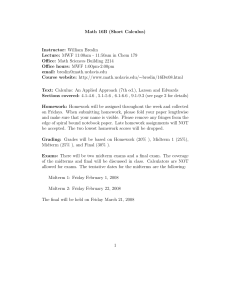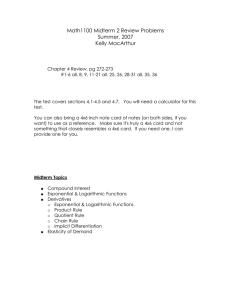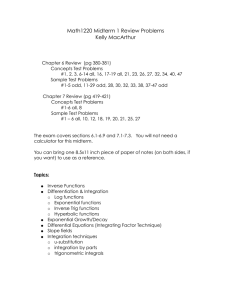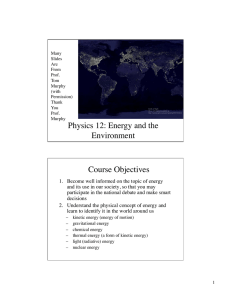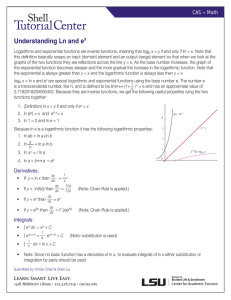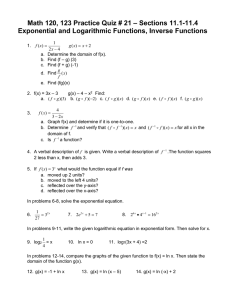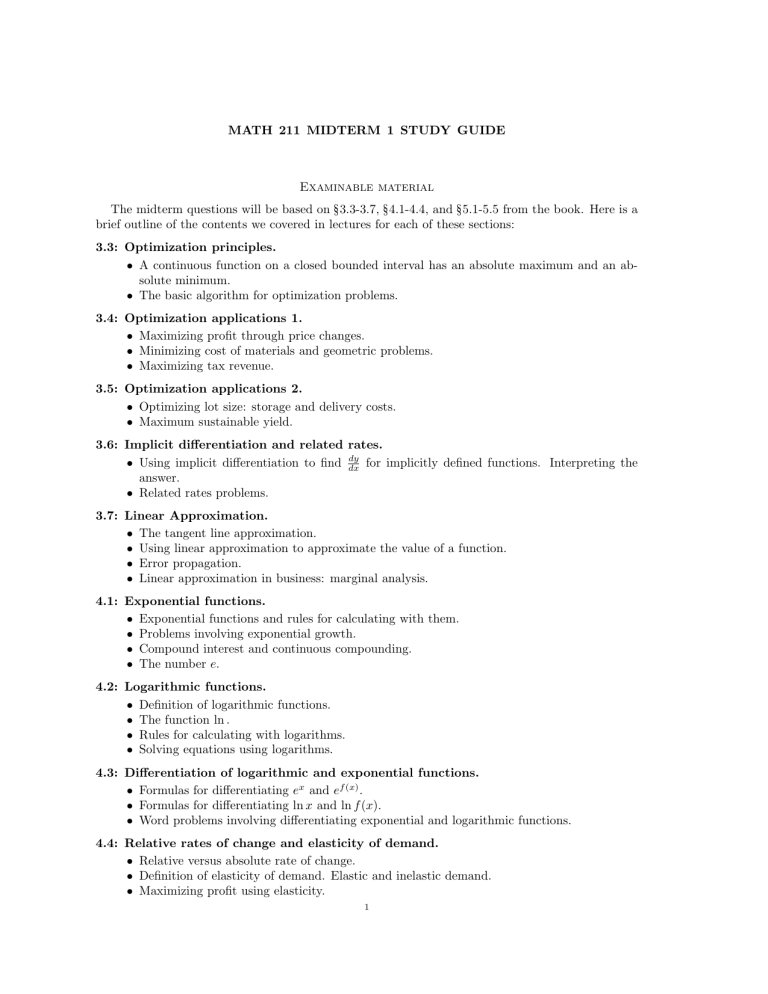
MATH 211 MIDTERM 1 STUDY GUIDE Examinable material The midterm questions will be based on §3.3-3.7, §4.1-4.4, and §5.1-5.5 from the book. Here is a brief outline of the contents we covered in lectures for each of these sections: 3.3: Optimization principles. • A continuous function on a closed bounded interval has an absolute maximum and an absolute minimum. • The basic algorithm for optimization problems. 3.4: Optimization applications 1. • Maximizing profit through price changes. • Minimizing cost of materials and geometric problems. • Maximizing tax revenue. 3.5: Optimization applications 2. • Optimizing lot size: storage and delivery costs. • Maximum sustainable yield. 3.6: Implicit differentiation and related rates. dy for implicitly defined functions. Interpreting the • Using implicit differentiation to find dx answer. • Related rates problems. 3.7: Linear Approximation. • The tangent line approximation. • Using linear approximation to approximate the value of a function. • Error propagation. • Linear approximation in business: marginal analysis. 4.1: Exponential functions. • Exponential functions and rules for calculating with them. • Problems involving exponential growth. • Compound interest and continuous compounding. • The number e. 4.2: Logarithmic functions. • Definition of logarithmic functions. • The function ln . • Rules for calculating with logarithms. • Solving equations using logarithms. 4.3: Differentiation of logarithmic and exponential functions. • Formulas for differentiating ex and ef (x) . • Formulas for differentiating ln x and ln f (x). • Word problems involving differentiating exponential and logarithmic functions. 4.4: Relative rates of change and elasticity of demand. • Relative versus absolute rate of change. • Definition of elasticity of demand. Elastic and inelastic demand. • Maximizing profit using elasticity. 1 2 MATH 211 MIDTERM 1 STUDY GUIDE 5.1: Antiderivatives and indefinite integrals. • Definition of antiderivative of a function. Definition of the indefinite integral of a function. • Basic rules for integration including the power rule. • Word problems involving recovering a quantity from its rate of change. 5.2: Integration using logarithmic and exponential functions. • Formula for integrating ekx . • Formula for integrating x1 . • Integration word problems involving exponential functions and 1 x. 5.3: Definite integrals and areas. • Approximating the area under a curve using Riemann sums (we will not emphasize this in the exam). • The definite integral interpreted as an area. • The fundamental theorem of integral calculus and uing it to calculate definite integrals. • Word problems finding the total change by integrating the instantaneous change. 5.4: Average value and area between curves. • Finding the average value of a function on an interval using integration. • Finding the area between two curves using integration. 5.5: Applications of integration to economics. • Definition of consumers’ and producers’ surpluses. • Definition of Gini index. Guidelines for answering questions Answer questions in enough detail that the grader can follow your calculations. If you use a rule, it is helpful to write something like “using the power rule” beside the line where you use the rule. By doing this, you ensure that you will receive some credit even if you make an algebra error. There will be no calculator allowed in the exam. You may leave your answers in terms of e, π, ln etc. Unless the question says otherwise, you do not have to fully simplify your answers. That said, it is still good to give a neat answer when you can. Unless a question says “using the definition of the derivative” you are free to use the power rule, product rule, quotient rule, chain rule, etc. If a question asks you to evaluate a limit that does not exist, then write “does not exist” and a justification. Partial credit is assigned for correct working out even if you do not give the final answer. Therefore, even if you cannot see how to fully answer a question, it is always worth attempting a question. MATH 211 MIDTERM 1 STUDY GUIDE 3 Sample questions The following questions are similar to the kinds of questions that will be on the exam. I will work through some of these problems in the midterm review classes (Monday 15 and Wednesday 17 November). Problem 1. $1000 is deposited in a savings account compounded continuously at an annual rate of 5%. Find the amount of time elapsed before the money doubles. Problem 2. Find the absolute maximum and absolute minimum of the function y = 27x3 − x on the interval [0, 1] . Remember to justify your answer. Problem 3. Differentiate the following functions with respect to x : a) f (x) = ln (ex − x) b) g(x) = ex ln x c) 1 h(x) = ln x2 + 1 Problem 4. Compute the following indefinite integrals: a) Z 1√ x dx 7x5 − 2 b) Z √ e3x dx c) Z q2 − 5 dq q Problem 5. The sides of a cube are growing at a rate of 1 inch per minute. Find the rate of change of a. the surface area of the cube and b. the volume of the cube when the sides are of length 3 inches. Give units in your answer. Problem 6. Let x and y be related by the equation x3 y + xy 2 + y = y 2 + x2 . Find a formula for in terms of x and y. dy dx Problem 7. The cost of manufacturing a laptop is given by √ C(x) = 100 x + 2 dollars, where x is the number produced (in thousands). Use C(4) and M C(4) to approximate the cost of producing 4100 laptops. Problem 8. Find the area bounded by the curves f (x) = 10x2 , g(x) = 10x3 , and the lines x = 1, x = 2. 4 MATH 211 MIDTERM 1 STUDY GUIDE Problem 9. Find the average value of the function f (x) = e2x + x2 on the interval [−1, 1] . Problem 10. An audio company estimates demand for high-end headphones to be 2000 per year. Each set of headphones costs $100 to manufacture, plus set up costs of $1000 per production run. If a pair of headphones can be stored for a year for a cost of $1, how many production runs should there be to minimize costs? Problem 11. Differentiate ln et t+1 with respect to t. Problem 12. A company is manufacturing an open-top box with a square base to have a volume of 64 cubic feet. The material used to make the base of the box costs $4 per square foot, while the material used to make the sides costs $2 per square foot. Find the dimensions of the box that minimize production costs. Other resources The take-home homework is another good collection of problems similar to the midterm. If you want to work on simpler problems, then the textbook has many relevant exercises after each section. The chapter review problems are also very good. Past midterms and finals are available, see the Canvas homepage.
